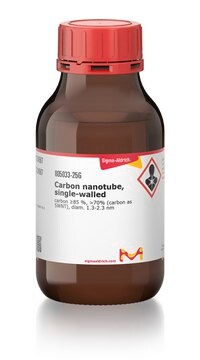704121
Carbon nanotube, single-walled
(7,6) chirality, ≥90% carbon basis (≥77% as carbon nanotubes), 0.83 nm average diameter, avg. no. of layers, 1
Synonym(s):
CHASM™, CNT, Signis® SG76, SWCNT, SWNT, Single wall carbon nanotube
About This Item
Recommended Products
description
G/D Ratio: ≥15 (Raman 633nm)
Median length: 1 μm
Assay
≥90% carbon basis (≥77% as carbon nanotubes)
form
powder (freeze-dried)
feature
avg. no. of layers 1
manufacturer/tradename
Signis® SG76
surface area
≥700 m2/g
impurities
≤5 wt. % Moisture content
average diameter
0.83 nm
mp
3652-3697 °C (lit.)
density
1.7-1.9 g/cm3 at 25 °C (lit.)
bulk density
0.1 g/cm3
SMILES string
[C]
InChI
1S/C
InChI key
OKTJSMMVPCPJKN-UHFFFAOYSA-N
Looking for similar products? Visit Product Comparison Guide
Related Categories
General description
Application
Preparation Note
Legal Information
Storage Class Code
11 - Combustible Solids
WGK
WGK 3
Flash Point(F)
Not applicable
Flash Point(C)
Not applicable
Personal Protective Equipment
Choose from one of the most recent versions:
Already Own This Product?
Find documentation for the products that you have recently purchased in the Document Library.
Customers Also Viewed
Articles
This article gives a brief overview of the physico-chemical nature and characterization of single-walled nanotubes (SWNTs).
The CoMoCAT® method of single-walled carbon nanotube (SWNT) synthesis yields high purity SWNTs with specific chiralities and narrow distributions of tube diameters.
Single-Walled Carbon Nanotubes synthesized by the Super-Growth Method & their properties & applications, including dispersing SGCNTs, SGCNT-polymer composites & SGCNT-metal composites are discussed.
Review the potential of self-assembled multilayer gate dielectric films fabricated from silane precursors for organic, inorganic, and transparent TFT and for TFT circuitry and OLED displays.
Protocols
In a typical dispersion procedure, a surfactant is adsorbed on the single-walled carbon nanotubes (SWCNTs) surface and the solution is sonicated, resulting in the debundling or exfoliation of the carbon nanotubes.
Our team of scientists has experience in all areas of research including Life Science, Material Science, Chemical Synthesis, Chromatography, Analytical and many others.
Contact Technical Service



